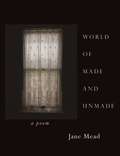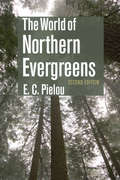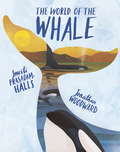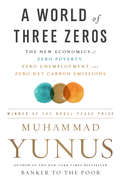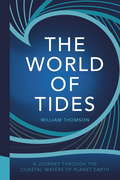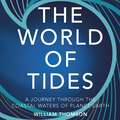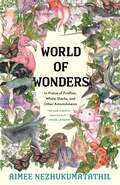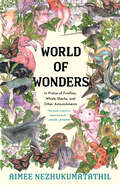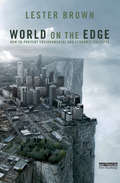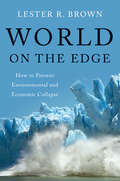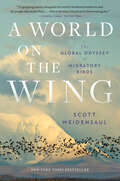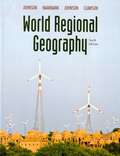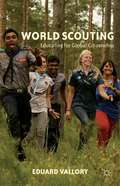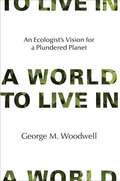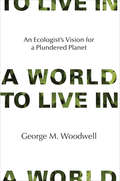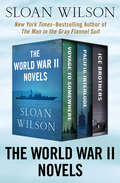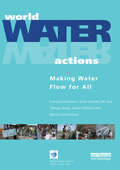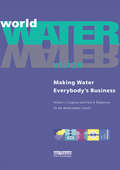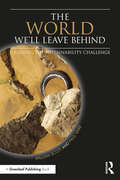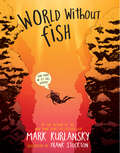- Table View
- List View
World of Made and Unmade
by Jane MeadMead's fifth collection candidly and openly explores the long process that is death. These resonant poems discover what it means to live, die, and come home again. We're drawn in by sorrow and grief, but also the joys of celebrating a long life and how simple it is to find laughter and light in the quietest and darkest of moments.
The World of Northern Evergreens
by E. C. PielouPraise for the first edition—"This book is guaranteed to enrich the reader's next forest visit."—Library Journal"Pielou's book brings forest ecology to naturalists, bird lovers, hikers, cyclists, canoeists, skiers, mountaineers, and back-country campers."—Seattle Post-Intelligencer"It is E. C. Pielou's contention that evergreen forests... are taken for granted and rarely well understood. To remedy this, the distinguished biogeographer has written a book focusing on the northern evergreen forests. This is a book that many naturalists, both novice and experienced, will read with pleasure and interest."—Canadian Field-Naturalist "Pielou makes a strong, irrefutable, case for the preservation of old-growth forests and wilderness. Anyone who appreciates the outdoors should have this book and take its message to heart."—Forest Planning Canada Global warming and human-driven impacts from logging, natural gas drilling, mining of oil sands, and the development of hydropower increasingly threaten North America's northern forests. These forests are far from being a uniform environment; close inspection reveals that the conifers that thrive there—pines, larches, spruces, hemlocks, firs, Douglas-firs, arborvitaes, false-cypresses, junipers, and yews—support a varied and complex ecosystem. In The World of Northern Evergreens, the noted ecologist E. C. Pielou introduces the biology of the northern forests and provides a unique invitation to naturalists, ecologists, foresters, and everyone living in northern North America who wants to learn about this unique and threatened northern world and the species that make it their home. Through identification keys, descriptions, and life histories of the conifer tree species, the author emphasizes how different these plants are both biologically and evolutionarily from the hardwoods we also call "trees." Following this introduction to the essential conifers, the author's perceptive insights expand to include the interactions of conifers with other plants, fungi, mammals, birds, and amphibians. The second edition, enriched by new illustrations by the author of woodland features and creatures, updates the text to include new topics including mycorrhizal fungi, soil, woodlice, bats, and invasive insects such as the hemlock woolly adelgid. Emphasis is given to the very real human-driven impacts that threaten the species that live in and depend on the vital and complex forest ecosystem. Pielou provides us with a rich understanding of the northern forests in this work praised for its nontechnical presentation, scientific objectivity, and original illustrations.
The World of the Beaver
by Leonard Lee Rue III"According to a Cherokee legend," writes Leonard Lee Rue in The World of the Beaver, "it was the Great Spirit, with the help of gigantic beavers, who created the earth. The earth had been covered with water until the Great Spirit sent the beavers diving down beneath the surface to dredge up mud from the bottom to form land masses." Although the beaver is not, nowadays, as big as his legendary ancestors, he continues to be enormously helpful to man and beast. Here Leonard Lee Rue reveals the world and way of life of the good -natured, industrious American beaver and follows him through a full year of his ordinary activities. How does a beaver fell a tree? What does he eat? Is he polygamous or monogamous? How does he build a dam? What does the inside of his lodge look like? Who has been his most deadly enemy in America? The author-whose interest in beavers has caused him to go swimming with them and, on one occasion, led to his becoming stuck in the passage to a lodge-answers all these questions and many others. The informal narrative and the author's remarkable photographs make this really first-rate reading for the nature student and for the ordinary reader. "As intent as man seems to be on destroying the earth," writes Leonard Lee Rue in conclusion, "the Creator may again have to call upon the beavers to help patch things up. The earth's future couldn't be in better paws."
The World of the Bobcat (A Living World Book)
by Joe Van WormerCan anybody really "lick his weight in wildcats?" Never, says Joe Van Wormer in this magnificent photo-and- text study of Lynx rufus, better known as the bobcat, or wildcat. In fact, he says, it is extremely doubtful that a 200-pound man could handle the average bobcat, which weighs less than 20 pounds. The bobcat is an elusive and secretive creature, and although he often lives close to civilization, it is impossible to make any prolonged observation of him in the wild. Joe Van Wormer, however, has observed bobcats' dens and followed their trails. He has talked to many people who hunt or own them. He has known a number of domesticated bobcats and has encountered many wild ones, often with the treed cat crouching on one limb and himself, with camera, on another only six or eight feet away. What is the family unit of the bobcat? Where does he live and what does he eat? How does he feel about humans? About his cousin, the house cat? Who are his natural enemies? The informal text and breath-taking photographs are a revelation of the temperament, habits, and lives of these strikingly beautiful nocturnal creatures - whose yellowish eyes, it was once believed, could see through wood and stone.
The World of the Gull (A Living World Book)
by David F. CostelloThe world of the gull extends from the barren Arctic wastes to the burning sands of Arabia, from the storm clouds of Tierra del Fuego to the farmlands of our own Great Plains. Equipped with extraordinary flying ability, intelligence, and an enviable digestion, gulls lead strange and wonderful lives. Born opportunists, they are completely adaptable, self-sufficient creatures, equally at home on land or sea-one of the few members of the animal kingdom able to drink both fresh and salt water. Unlike most other birds, gulls walk, fly, and swim with ease. These capabilities put them in touch with an unlimited variety of food-from cherries, mice, brine fly larvae, wheat, and steak bones to eggs, worms, and young ducks-and make them one of nature's most valuable scavengers. David Costello describes all aspects of the gulls' life cycle-their ritualistic courtship and nesting habits, the rearing of their young, colony formation, food finding, natural enemies, and their remarkable migrations over the face of the earth.
The World of the Otter (Living World Book)
by Ed ParkEver wondered how those otters on the river bank are so playful, what do they eat, where do they live, how do they survive the winter? In this book by naturalist Ed Park, who has studied otters for years, you will find the answers to these questions and get to know the clowns of the river bank more closely.
The World of the Whale
by Smriti Prasadam-HallsDive into the underwater world of whales and dolphins in this entrancing illustrated guide. Graceful and serene, intelligent and social, the whale is a wonder of the deep blue sea. And yet, whales rely on air to breathe - they are mammals, just like us.With breathtaking text, Smriti Prasadam-Halls explores the migrations, songs and family life of these mysterious creatures, and reveals the dangers they face from plastic, pollution and hunting. Wildlife illustrator Jonathan Woodward brings the marine world to life with stunning papercut collage artwork. An astonishing follow-up to the English 4-11 Award-winning book The Ways of the Wolf, which is also shortlisted for the SLA Award.'The expressive writing and the colourful, original artwork depict the lives of whales perfectly. Perceptively illustrating their strong social nature and intelligence, this beautiful book also explores the dangers faced by these incredible creatures and the need for us to work together to protect them.' - Whale & Dolphin Conservation
A World of Three Zeros: The New Economics Of Zero Poverty, Zero Unemployment, And Zero Carbon Emissions
by Muhammad YunusA winner of the Nobel Peace Prize and bestselling author of Banker to the Poor offers his vision of an emerging new economic system that can save humankind and the planet Muhammad Yunus, who created microcredit, invented social business, and earned a Nobel Peace Prize for his work in alleviating poverty, is one of today's most trenchant social critics. Now he declares it's time to admit that the capitalist engine is broken--that in its current form it inevitably leads to rampant inequality, massive unemployment, and environmental destruction. We need a new economic system that unleashes altruism as a creative force just as powerful as self-interest. Is this a pipe dream? Not at all. In the last decade, thousands of people and organizations have already embraced Yunus's vision of a new form of capitalism, launching innovative social businesses designed to serve human needs rather than accumulate wealth. They are bringing solar energy to millions of homes in Bangladesh; turning thousands of unemployed young people into entrepreneurs through equity investments; financing female-owned businesses in cities across the United States; bringing mobility, shelter, and other services to the rural poor in France; and creating a global support network to help young entrepreneurs launch their start-ups. In A World of Three Zeros, Yunus describes the new civilization emerging from the economic experiments his work has helped to inspire. He explains how global companies like McCain, Renault, Essilor, and Danone got involved with this new economic model through their own social action groups, describes the ingenious new financial tools now funding social businesses, and sketches the legal and regulatory changes needed to jumpstart the next wave of socially driven innovations. And he invites young people, business and political leaders, and ordinary citizens to join the movement and help create the better world we all dream of.
The World of Tides: A Journey Through the Coastal Waters of Planet Earth
by William ThomsonIn The Book of Tides, William Thomson took the reader on a mesmerising journey round the coast of Britain. Now, he sets out with his surfboard and tidal compass to encounter the waters of the world, charting his most extraordinary sights and experiences. These include the whirlpools of the Arctic circle, the world's biggest ever surfed wave off Portugal, the strongest whirlpool in Norway and, in Australia, the most dangerous rapids known to us.With the enticing combination of William's passionate text and collectable mapping illustrations, this is a book for anyone who feels the pull of the tides and call of the sea.FEATURING:New ZealandAustraliaPortugalFranceEnglandScotlandNorwayThe NetherlandsSpainIndonesiaChinaJapanUSACanadaBelize
The World of Tides: A Journey Through the Coastal Waters of Planet Earth
by William ThomsonIn The Book of Tides, William Thomson took the reader on a mesmerising journey round the coast of Britain. Now, he sets out with his surfboard and tidal compass to encounter the waters of the world, charting his most extraordinary sights and experiences. These include the whirlpools of the Arctic circle, the world's biggest ever surfed wave off Portugal, the strongest whirlpool in Norway and, in Australia, the most dangerous rapids known to us.With the enticing combination of William's passionate text and collectible mapping illustrations, this is a book for anyone who feels the pull of the tides and call of the sea.FEATURING:New ZealandAustraliaPortugalFranceEnglandScotlandNorwayThe NetherlandsSpainIndonesiaChinaJapanUSACanadaBelize(P)2017 Quercus Editions Limited
World of Wonders: In Praise of Fireflies, Whale Sharks, and other Astonishments
by Aimee NezhukumatathilFrom beloved, award-winning poet Aimee Nezhukumatathil comes a debut work of nonfiction-a collection of essays about the natural world, and the way its inhabitants can teach, support, and inspire us.
World of Wonders: In Praise of Fireflies, Whale Sharks, and Other Astonishments
by Aimee Nezhukumatathil“A poet celebrates the wonders of nature in a collection of essays that could almost serve as a coming-of-age memoir.” —Kirkus ReviewsAs a child, Nezhukumatathil called many places home: the grounds of a Kansas mental institution, where her Filipina mother was a doctor; the open skies and tall mountains of Arizona, where she hiked with her Indian father; and the chillier climes of western New York and Ohio. But no matter where she was transplanted—no matter how awkward the fit or forbidding the landscape—she was able to turn to our world’s fierce and funny creatures for guidance.“What the peacock can do,” she tells us, “is remind you of a home you will run away from and run back to all your life.” The axolotl teaches us to smile, even in the face of unkindness; the touch-me-not plant shows us how to shake off unwanted advances; the narwhal demonstrates how to survive in hostile environments. Even in the strange and the unlovely, Nezhukumatathil finds beauty and kinship. For it is this way with wonder: it requires that we are curious enough to look past the distractions in order to fully appreciate the world’s gifts.Warm, lyrical, and gorgeously illustrated by Fumi Nakamura, World of Wonders is a book of sustenance and joy.Praise for World of WondersBarnes & Noble 2020 Book of the YearAn NPR Best Book of 2020An Esquire Best Book of 2020A Publishers Weekly “Big Indie Book of Fall 2020”A BuzzFeed Best Book of Fall 2020“Hands-down one of the most beautiful books of the year.” —NPR“A timely story about love, identity and belonging.” —New York Times Book Review“A truly wonderous essay collection.” —Roxane Gay, The Audacity
World on the Edge: How to Prevent Environmental and Economic Collapse
by Lester BrownIn this urgent time, World on the Edge calls out the pivotal environmental issues and how to solve them now. We are in a race between political and natural tipping points. Can we close coal-fired power plants fast enough to save the Greenland ice sheet and avoid catastrophic sea level rise? Can we raise water productivity fast enough to halt the depletion of aquifers and avoid water-driven food shortages? Can we cope with peak water and peak oil at the same time? These are some of the issues Lester R. Brown skilfully distils in World on the Edge. Bringing decades of research and analysis into play, he provides the responses needed to reclaim our future.
World on the Edge: How to Prevent Environmental and Economic Collapse
by Lester R. BrownIn this urgent time, World on the Edge calls out the pivotal environmental issues and how to solve them now. We are in a race between political and natural tipping points. Can we close coal-fired power plants fast enough to save the Greenland ice sheet and avoid catastrophic sea level rise? Can we raise water productivity fast enough to halt the depletion of aquifers and avoid water-driven food shortages? Can we cope with peak water and peak oil at the same time? These are some of the issues Lester R. Brown skillfully distills in World on the Edge. Bringing decades of research and analysis into play, he provides the responses needed to reclaim our future.
A World on the Wing: The Global Odyssey Of Migratory Birds
by Scott WeidensaulNew York Times Bestseller Finalist for the Los Angeles Times Book Prize A Library Journal Best Science and Technology Book of the Year An exhilarating exploration of the science and wonder of global bird migration. In the past two decades, our understanding of the navigational and physiological feats that enable birds to cross immense oceans, fly above the highest mountains, or remain in unbroken flight for months at a stretch has exploded. What we’ve learned of these key migrations—how billions of birds circumnavigate the globe, flying tens of thousands of miles between hemispheres on an annual basis—is nothing short of extraordinary. Bird migration entails almost unfathomable endurance, like a sparrow-sized sandpiper that will fly nonstop from Canada to Venezuela—the equivalent of running 126 consecutive marathons without food, water, or rest—avoiding dehydration by "drinking" moisture from its own muscles and organs, while orienting itself using the earth’s magnetic field through a form of quantum entanglement that made Einstein queasy. Crossing the Pacific Ocean in nine days of nonstop flight, as some birds do, leaves little time for sleep, but migrants can put half their brains to sleep for a few seconds at a time, alternating sides—and their reaction time actually improves. These and other revelations convey both the wonder of bird migration and its global sweep, from the mudflats of the Yellow Sea in China to the remote mountains of northeastern India to the dusty hills of southern Cyprus. This breathtaking work of nature writing from Pulitzer Prize finalist Scott Weidensaul also introduces readers to those scientists, researchers, and bird lovers trying to preserve global migratory patterns in the face of climate change and other environmental challenges. Drawing on his own extensive fieldwork, in A World on the Wing Weidensaul unveils with dazzling prose the miracle of nature taking place over our heads.
World Regional Geography (10th edition)
by David L. Clawson Merrill L. Johnson Douglas L. Johnson Viola HaarmannPulling from an impressive team of ten authors, each chapter in this book has been authored by an expert in the region to provide the utmost accuracy and relevancy. World Regional Geography explores the character of the world's people, with a central theme of human development, for an issues-oriented overview of each region. An emphasis on subregions (places within regions) enables readers to explore specific locales. An economic development theme offers a more conceptual treatment than the traditional coverage of this topic. Basic Concepts and Ideas; The United States and Canada; Latin America and the Caribbean; Europe; Northern Eurasia; Central Asia and Afghanistan; The Middle East and North Africa; Africa South of the Sahara; South Asia; East Asia; Southeast Asia; Australia, New Zealand, and the Pacific Islands. The useful references for anyone who wants to learn more about the different regions of the world.
World Scouting
by Eduard ValloryThis is the very first book to look at scouting worldwide and explain in a comprehensible way the largest youth movement on the planet, with a presence in over 165 countries on 5 continents. Based on the first academic research on world scouting, it covers the history of boy and girl scouting from its origins to the present, its structure and recognition policy, and its role in developing ideas of global citizenship and belonging. Using new data and storytelling, Eduard Vallory discusses the main elements that distinguish the scout movement all over the world; explains its origin, evolution, operating system, and values; and deals with its controversies.
A World to Live In
by George M. WoodwellA century of industrial development is the briefest of moments in the half billion years of the earth's evolution. And yet our current era has brought greater changes to the earth than any period in human history. The biosphere, the globe's life-giving envelope of air and climate, has been changed irreparably. In A World to Live In, the distinguished ecologist George Woodwell shows that the biosphere is now a global human protectorate and that its integrity of structure and function are tied closely to the human future. The earth is a living system, Woodwell explains, and its stability is threatened by human disruption. Industry dumps its waste globally and makes a profit from it, invading the global commons; corporate interests overpower weak or nonexistent governmental protection to plunder the planet. The fossil fuels industry offers the most dramatic example of environmental destruction, disseminating the heat-trapping gases that are now warming the earth and changing the climate forever. The assumption that we can continue to use fossil fuels and "adapt" to climate disruption, Woodwell argues, is a ticket to catastrophe.But Woodwell points the way toward a solution. We must respect the full range of life on earth -- not species alone, but their natural communities of plant and animal life that have built, and still maintain, the biosphere. We must recognize that the earth's living systems are our heritage and that the preservation of the integrity of a finite biosphere is a necessity and an inviolable human right.
A World to Live In: An Ecologist's Vision for a Plundered Planet
by George M. WoodwellA scientist makes a powerful case that preservation of the integrity of the biosphere is a necessity and an inviolable human right.A century of industrial development is the briefest of moments in the half billion years of the earth's evolution. And yet our current era has brought greater changes to the earth than any period in human history. The biosphere, the globe's life-giving envelope of air and climate, has been changed irreparably. In A World to Live In, the distinguished ecologist George Woodwell shows that the biosphere is now a global human protectorate and that its integrity of structure and function are tied closely to the human future. The earth is a living system, Woodwell explains, and its stability is threatened by human disruption. Industry dumps its waste globally and makes a profit from it, invading the global commons; corporate interests overpower weak or nonexistent governmental protection to plunder the planet. The fossil fuels industry offers the most dramatic example of environmental destruction, disseminating the heat-trapping gases that are now warming the earth and changing the climate forever. The assumption that we can continue to use fossil fuels and “adapt” to climate disruption, Woodwell argues, is a ticket to catastrophe.But Woodwell points the way toward a solution. We must respect the full range of life on earth—not species alone, but their natural communities of plant and animal life that have built, and still maintain, the biosphere. We must recognize that the earth's living systems are our heritage and that the preservation of the integrity of a finite biosphere is a necessity and an inviolable human right.
The World War II Novels: Voyage to Somewhere, Pacific Interlude, and Ice Brothers
by Sloan WilsonThree novels of life at sea during World War II from the bestselling author of The Man in the Gray Flannel Suit and A Summer Place. Drawing on his own experiences as a US Coast Guard officer, Sloan Wilson sheds a unique light on World War II in these three unforgettable novels. Voyage to Somewhere: Hoping to draw a nice, lengthy shore duty after two years at sea, Lieutenant Barton is instead told that he’s being sent right back out, this time as captain of a supply ship sailing from California to New Guinea and stopping at every small island in between. Despite being homesick for his wife, he has no choice but to accept the assignment and a cargo of pineapples destined for Hawaii. When Barton isn’t battling gale-force winds and monstrous waves, he’s coping with seasick sailors and budding rivalries that threaten to turn mutinous. Hanging over the ship like a storm cloud is the knowledge that the world is at war and the enemy is never far away. “One of the few honest and straightforward sea books that have come out of the war” (New York Herald Tribune).Pacific Interlude: Twenty-five-year-old Coast Guard lieutenant Sylvester Grant, a veteran of the Greenland Patrol, has just been given command of a small gas tanker carrying extremely flammable cargo across dangerous stretches of the Pacific Ocean. As the Allies prepare to retake the Philippines, Grant and his crew must bring two hundred thousand gallons of high-octane aviation fuel to shore. From below-deck personality clashes to the terrifying possibility of an enemy attack, from combating illness and boredom to the constant stress of preventing a deadly explosion, the crew of Y-18 must learn to work together and trust their captain—otherwise, they might never make it home. “Powerful, passionate and authentic . . . Unforgettable” (James Dickey, author of Deliverance). Ice Brothers: After the attack on Pearl Harbor, Paul Schuman, a college senior and summer sailor, enlists in the Coast Guard and is assigned to be the executive officer aboard the Arluk, a converted fishing trawler patrolling the coast of Greenland for secret German weather bases. Led by Lt. Cdr. “Mad” Mowry, the finest ice pilot and meanest drunk in the Coast Guard, Schuman and communications officer Nathan Greenberg battle deadly icebergs, dangerous blizzards, and menacing Nazi gunboats. Surviving the war will require every ounce of courage and intelligence they possess—and that’s before Mowry breaks, forcing the young officers to take command at the worst possible moment. “The best since The Caine Mutiny” (San Francisco Chronicle).
World Water Actions: Making Water Flow for All
by Francois GuerquinThis text is divided into three parts. Part I focuses on the need for management to assess the challenges of water scarcity and plan changes based on proper valuation and financial instruments, international co-operation and efficient use. Part II analyses the problems of water scarcity and the available solutions in each main sector: water supply and sanitation, energy, health, agriculture, ecosystems and biodiversity. Part III assesses the state of the debate following the third World Water Forum and sets out the priorities for action, including increased investment, institutional reform and capacity building in the water sector. Downloadable resources with extensive case studies and statistical data accompanies this text.
World Water Vision: Making Water Everybody's Business
by William J. Cosgrove Frank R. RijsbermanMore than a billion people cannot get safe drinking water; half the world's population does not have adequate sanitation; within a generation over three billion will be suffering from water stress. This text analyzes the issues in this crisis of management and shows how water can be used effectively and productively. The key to sustainable water resources is an integrated approach. The authors assert that careful planning and concerted action can make the fundamental changes needed and that the implications of not dealing with the crisis are immense. The book comes with a CD ROM containing background research and scenarios.
The World We'll Leave Behind: Grasping the Sustainability Challenge
by William Scott Paul VareIt is now clear that human activity has influenced how the biosphere supports life on Earth, and given rise to a set of connected environmental and social problems. In response to the challenge that these problems present, a series of international conferences and summits led to discussions of sustainable development and the core dilemma of our time: How can we all live well, now and in the future, without compromising the ability of the planet to enable us all to live well? This book identifies the main issues and challenges we now face; it explains the ideas that underpin them and their interconnection, and discusses a range of strategies through which they might be addressed and possibly resolved. These cover things that governments might do, what businesses and large organisations can contribute, and the scope for individuals, families and communities to get involved. This book is for everyone who cares about such challenges, and wants to know more about them.
World Without Fish
by Frank Stockton Mark Kurlansky"Can you imagine a world without fish? It's not as crazy as it sounds. But if we keep doing things the way we've been doing things, fish could become extinct within fifty years. So let's change the way we do things!" Announcing the paperback edition of World Without Fish, the uniquely illustrated narrative nonfiction account—for kids—of what is happening to the world’s oceans and what they can do about it. Written by Mark Kurlansky, the bestselling author of Cod, Salt, The Big Oyster, and many other books, World Without Fish has been praised as “urgent” (Publishers Weekly) and “a wonderfully fast-paced and engaging primer on the key questions surrounding fish and the sea” (Paul Greenberg, author of Four Fish).?It has also been included in the New York State Expeditionary Learning English Language Arts Curriculum. Written by a master storyteller, World Without Fish connects all the dots—biology, economics, evolution, politics, climate, history, culture, food, and nutrition—in a way that kids can really understand. It describes how the fish we most commonly eat, including tuna, salmon, cod, swordfish—even anchovies— could disappear within fifty years, and the domino effect it would have: the oceans teeming with jellyfish and turning pinkish orange from algal blooms, the seabirds disappearing, then reptiles, then mammals. It describes the back-and-forth dynamic of fishermen, who are the original environmentalists, and scientists, who not that long ago considered fish an endless resource. It explains why fish farming is not the answer—and why sustainable fishing is, and how to help return the oceans to their natural ecological balance. Interwoven with the book is a twelve-page full-color graphic novel. Each beautifully illustrated chapter opener links to the next to form a larger fictional story that perfectly complements the text.
